Coral bells, also known as Heuchera, are a popular perennial plant with vibrant, colorful foliage that can add a pop of color to any garden. They are versatile and can thrive in nearly all sun conditions, making them an excellent choice for gardeners looking to add some color to their outdoor space. One way to enhance their beauty is by planting them alongside companion plants.
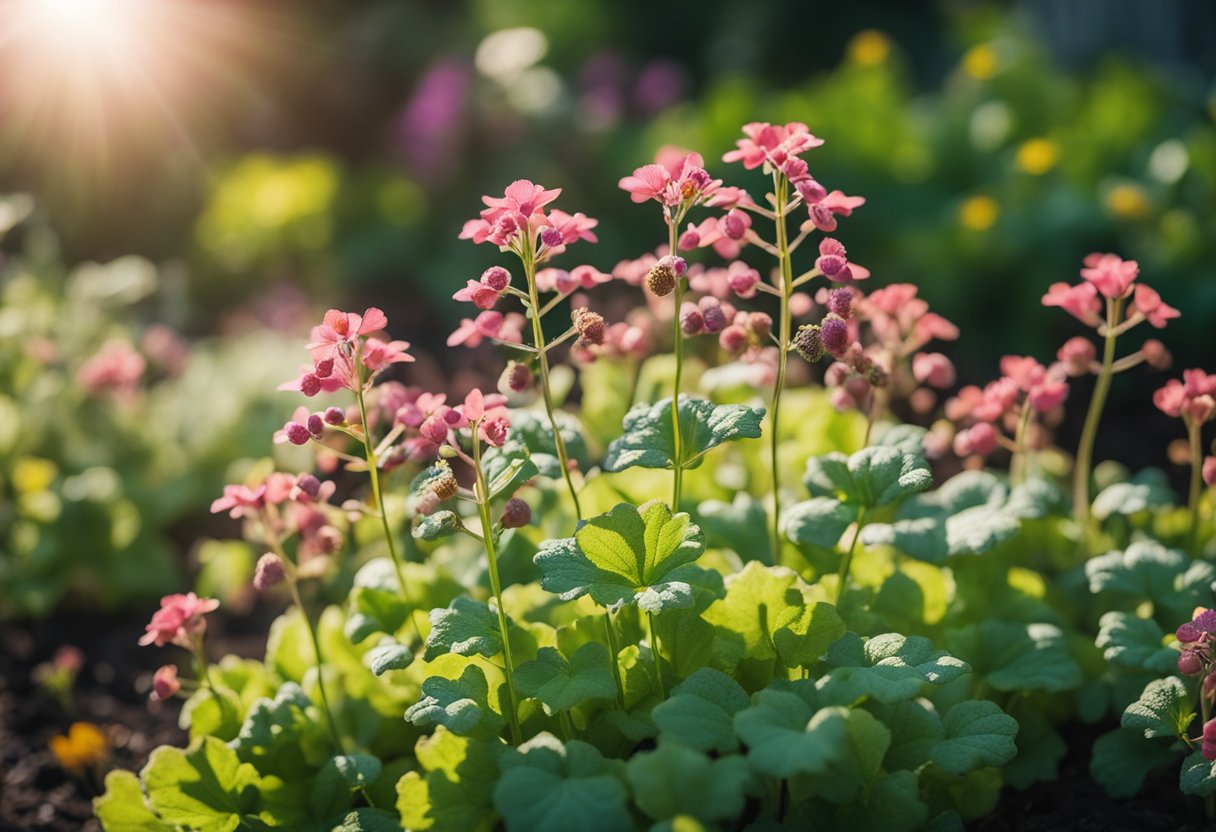
Companion planting is the practice of planting different plant species together to create a mutually beneficial relationship. When done correctly, companion planting can help improve soil health, deter pests, and increase yields. In the case of coral bells, companion planting can help enhance their beauty and create a harmonious garden design.
When choosing companion plants for coral bells, it’s important to consider factors such as soil type, sun exposure, and water requirements. Some plants that make excellent companions for coral bells include hostas, bleeding heart, astilbe, and hydrangeas. By planting these plants alongside coral bells, you can create a stunning garden that is sure to impress.
Key Takeaways
- Coral bells are a popular perennial plant with vibrant, colorful foliage that can thrive in nearly all sun conditions.
- Companion planting can help enhance the beauty of coral bells and create a harmonious garden design.
- When choosing companion plants for coral bells, it’s important to consider factors such as soil type, sun exposure, and water requirements.
Understanding Coral Bells

Characteristics of Coral Bells
Coral bells (Heuchera) are a popular perennial plant that is native to North America. They are known for their attractive foliage and delicate flowers that bloom in the spring and summer. Coral bells are available in a wide range of colors, including green, purple, red, and silver. They are also available in a variety of leaf shapes, including round, heart-shaped, and lobed.
Coral bells prefer well-drained soil and partial shade. They are relatively low-maintenance plants and can be grown in containers, borders, or as ground cover. Coral bells are also deer-resistant, making them a great choice for gardens with deer problems.
Benefits of Companion Planting
Companion planting is the practice of planting two or more different plants together to benefit each other. When it comes to coral bells, there are several plants that make great companions.
One of the benefits of companion planting with coral bells is pest control. Marigolds are known to repel a variety of pests, including aphids, nematodes, and whiteflies. Planting marigolds near coral bells can help keep these pests away and reduce the chances of an infestation.
Another benefit of companion planting with coral bells is aesthetic appeal. Impatiens are great plants to pair with coral bells because they are extremely tolerant of shade and available in various colors, including red, white, pink, purple, and yellow. The abundant flowers will improve the appearance of any garden with bright colors usually reserved for full-sunlight plants.
When it comes to choosing companion plants for coral bells, it’s important to consider the soil and light requirements of both plants. Coral bells prefer rich, moist, and well-drained soil with a neutral or slightly acidic pH level. They can tolerate almost any light quality, so there are an impressive number of ornamental plants capable of thriving alongside coral bells.
Designing Your Garden
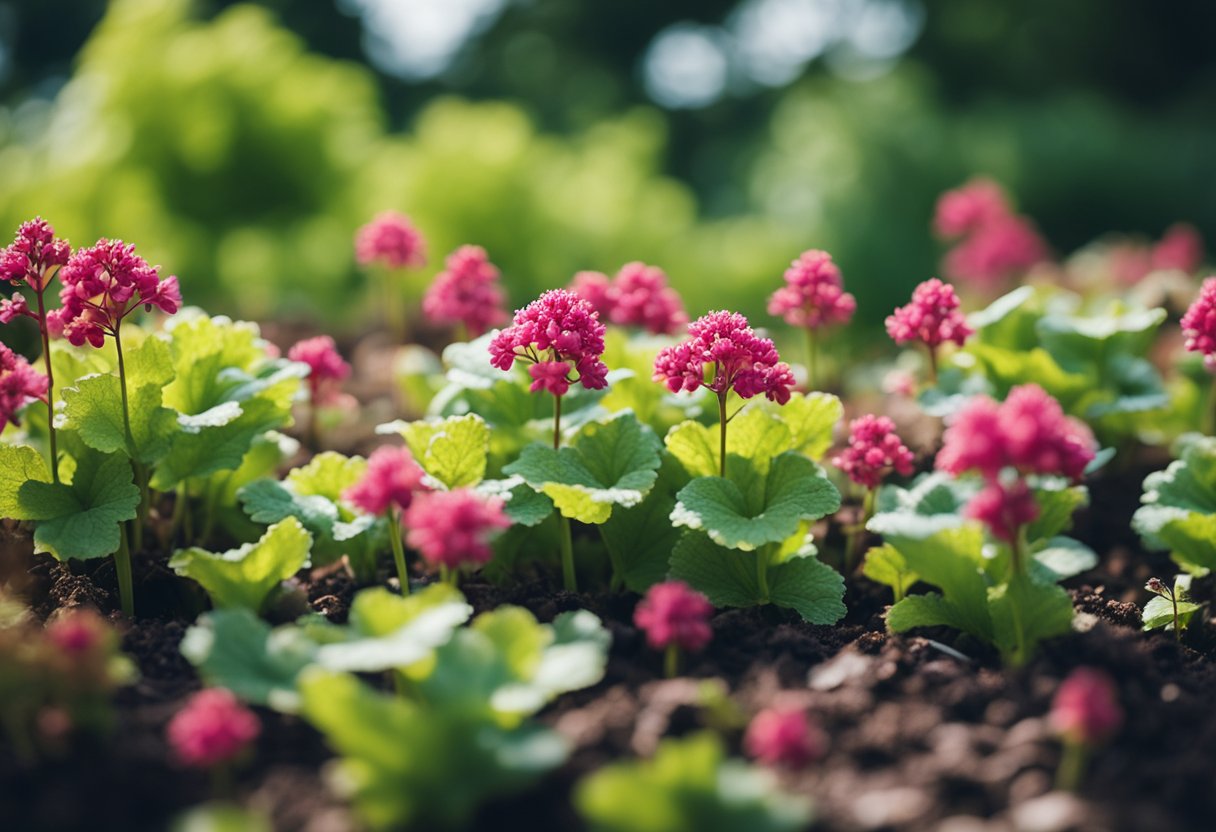
When it comes to designing a garden that includes coral bells, there are a few key factors to consider. By taking into account color coordination, texture contrasts, and spatial arrangement, you can create a visually stunning and cohesive garden that will make your coral bells truly shine.
Color Coordination
One of the most important aspects of designing a garden with coral bells is color coordination. Coral bells come in a wide range of colors, from bright greens and yellows to deep purples and reds. When choosing companion plants, it’s important to consider the colors of your coral bells and choose plants that will complement or contrast with them in interesting ways.
For example, if you have coral bells with bright green leaves, you might consider pairing them with plants that have deep red or purple foliage, such as heuchera ‘Obsidian’ or heuchera ‘Palace Purple’. On the other hand, if you have coral bells with deep purple leaves, you might choose to pair them with plants that have bright green or yellow foliage, such as hostas or Japanese forest grass.
Texture Contrasts
In addition to color coordination, texture contrasts can also play an important role in creating a visually interesting garden with coral bells. Coral bells have a soft, almost fuzzy texture that can be complemented by plants with smooth, glossy leaves or rough, textured foliage.
For example, you might consider pairing coral bells with plants like Japanese painted ferns or heuchera ‘Caramel’ that have delicate, lacy foliage. Alternatively, you might choose to pair coral bells with plants like hostas or heuchera ‘Obsidian’ that have large, smooth leaves.
Spatial Arrangement
Finally, when designing a garden with coral bells, it’s important to consider the spatial arrangement of your plants. Coral bells are relatively low-growing plants, so it’s important to choose companion plants that won’t overshadow or crowd them out.
One approach is to create a layered garden bed, with taller plants at the back and shorter plants at the front. This can help to create a sense of depth and dimension in your garden while ensuring that your coral bells have plenty of space to grow and thrive.
Designing a garden with coral bells can be a fun and rewarding experience. By taking into account color coordination, texture contrasts, and spatial arrangement, you can create a beautiful and cohesive garden that will showcase the unique beauty of your coral bells.
Companion Planting Basics
When it comes to companion planting with Coral Bells, it’s important to consider the plant’s needs and requirements. Coral Bells are a popular choice for gardeners because they are easy to grow and come in a variety of colors. However, they can benefit from the company of other plants that complement their growth habits and help them thrive. In this section, I will discuss the basics of companion planting with Coral Bells.
Sunlight Requirements
Coral Bells thrive in partial shade to full sun, depending on the variety. When choosing companion plants, it’s important to consider their sunlight requirements. Some plants that do well in partial shade include Hostas, Bleeding Heart, and Astilbe. If you’re looking for plants that prefer full sun, consider planting Coral Bells with Daylilies, Coneflowers, or Black-Eyed Susans.
Soil Conditions
Coral Bells prefer well-draining soil that is rich in organic matter. When selecting companion plants, it’s important to choose plants that have similar soil requirements. Some plants that do well in well-draining soil include Iris, Caladium, and Begonia. If you’re looking for plants that prefer more moisture, consider planting Coral Bells with Hydrangeas or Ferns.
Watering Needs
Coral Bells require regular watering to thrive, especially during hot and dry weather. When selecting companion plants, it’s important to choose plants that have similar watering needs. Some plants that do well with regular watering include Ferns, Astilbe, and Hostas. If you’re looking for plants that require less water, consider planting Coral Bells with Succulents or Lavender.
When selecting companion plants for Coral Bells, it’s important to consider their sunlight requirements, soil conditions, and watering needs. By choosing plants that complement Coral Bells’ growth habits, you can create a beautiful and thriving garden.
Best Companion Plants for Coral Bells
Coral bells (Heuchera spp.) are beautiful, low-growing perennials that come in a variety of colors and thrive in nearly all sun conditions. They are versatile and add a pop of color to any garden. However, planting them alongside other ornamental plants can make them stand out even more. Here are some of the best companion plants for coral bells:
Spring Bulbs
Spring bulbs such as tulips, daffodils, and crocuses are great companions for coral bells because they bloom in early spring and add a burst of color to the garden. Planting them alongside coral bells creates a beautiful contrast of colors and textures. They also prefer similar growing conditions, making them ideal companions.
Ferns
Ferns are another great companion for coral bells. They thrive in the shade and add a lush, green backdrop to the colorful coral bells. Some great ferns to plant alongside coral bells include the Japanese painted fern, the lady fern, and the ostrich fern. They provide a nice contrast of colors and textures and require similar growing conditions.
Hostas
Hostas are a classic companion for coral bells. They both enjoy a similar growing environment, and the thick, shiny leaves of the hosta can help prevent foraging animals like rabbits and deer from eating the coral bells. Planting them together creates a visually appealing and well-balanced garden. Some great hostas to plant alongside coral bells include the blue hosta, the golden hosta, and the variegated hosta.
Planting coral bells alongside complementary plants is a great way to create a visually appealing and well-balanced garden. Spring bulbs, ferns, and hostas are just a few of the many great companion plants for coral bells. By planting them together, you can create a beautiful and thriving garden that will be the envy of all your neighbors.
Avoiding Poor Companions
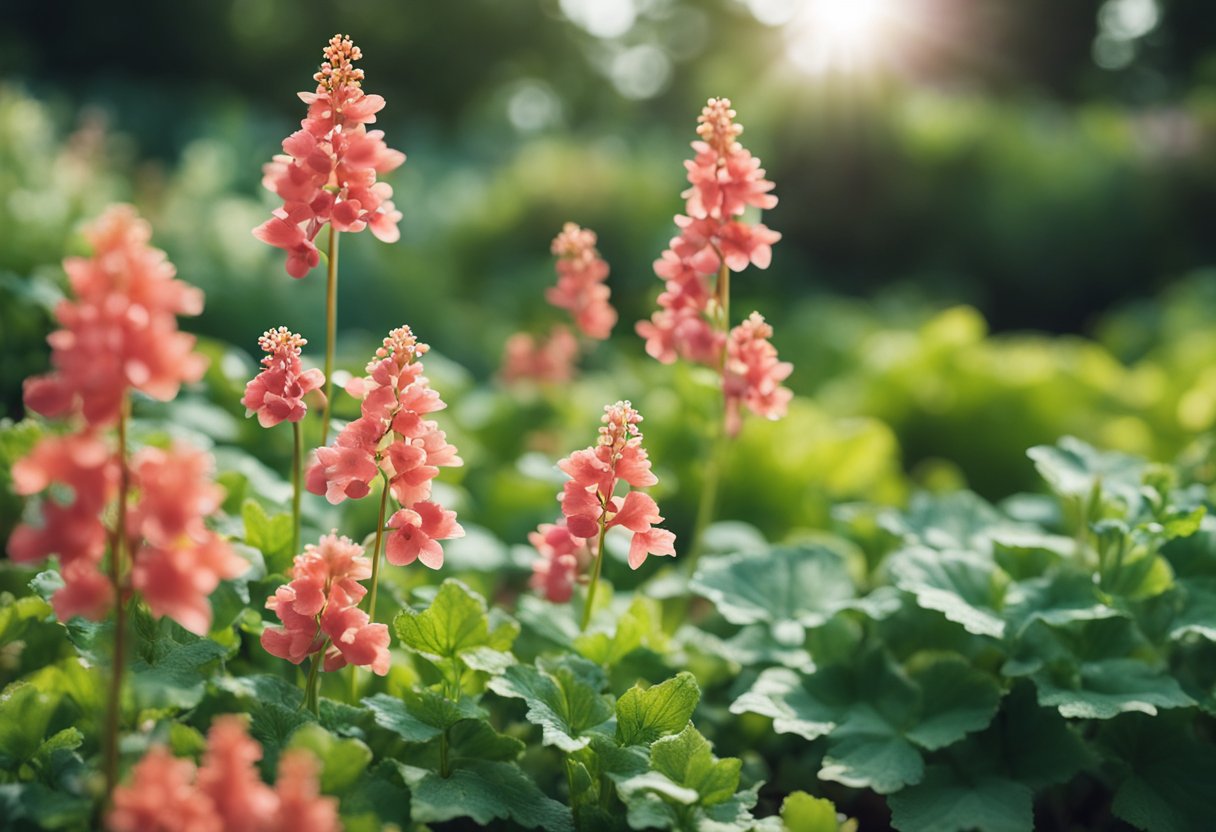
When selecting companion plants for coral bells, it is important to avoid certain species that may harm or inhibit their growth. Some plants can be invasive, while others may release chemicals that are harmful to coral bells. In this section, I will discuss two types of plants to avoid when selecting companion plants for coral bells.
Invasive Species
Invasive species are plants that can quickly take over an area and outcompete native plants. These plants can be harmful to ecosystems and can cause damage to other plants in the area. When selecting companion plants for coral bells, it is important to avoid invasive species that can harm or inhibit their growth.
One example of an invasive species to avoid is the Purple Loosestrife (Lythrum salicaria). This plant is known for its beautiful purple flowers, but it can quickly take over an area and outcompete native plants. It can also release chemicals that are harmful to other plants, including coral bells.
Allelopathic Plants
Allelopathic plants are plants that release chemicals that can inhibit the growth of other plants. When selecting companion plants for coral bells, it is important to avoid allelopathic plants that can harm or inhibit their growth.
One example of an allelopathic plant to avoid is the Black Walnut (Juglans nigra). This plant releases a chemical called juglone that can be harmful to other plants, including coral bells. Other allelopathic plants to avoid include the Tree of Heaven (Ailanthus altissima) and the Norway Maple (Acer platanoides).
By avoiding invasive species and allelopathic plants, you can ensure that your coral bells thrive and grow to their full potential. When selecting companion plants, be sure to do your research and choose plants that are known to grow well alongside coral bells.
Caring for Coral Bells and Companions
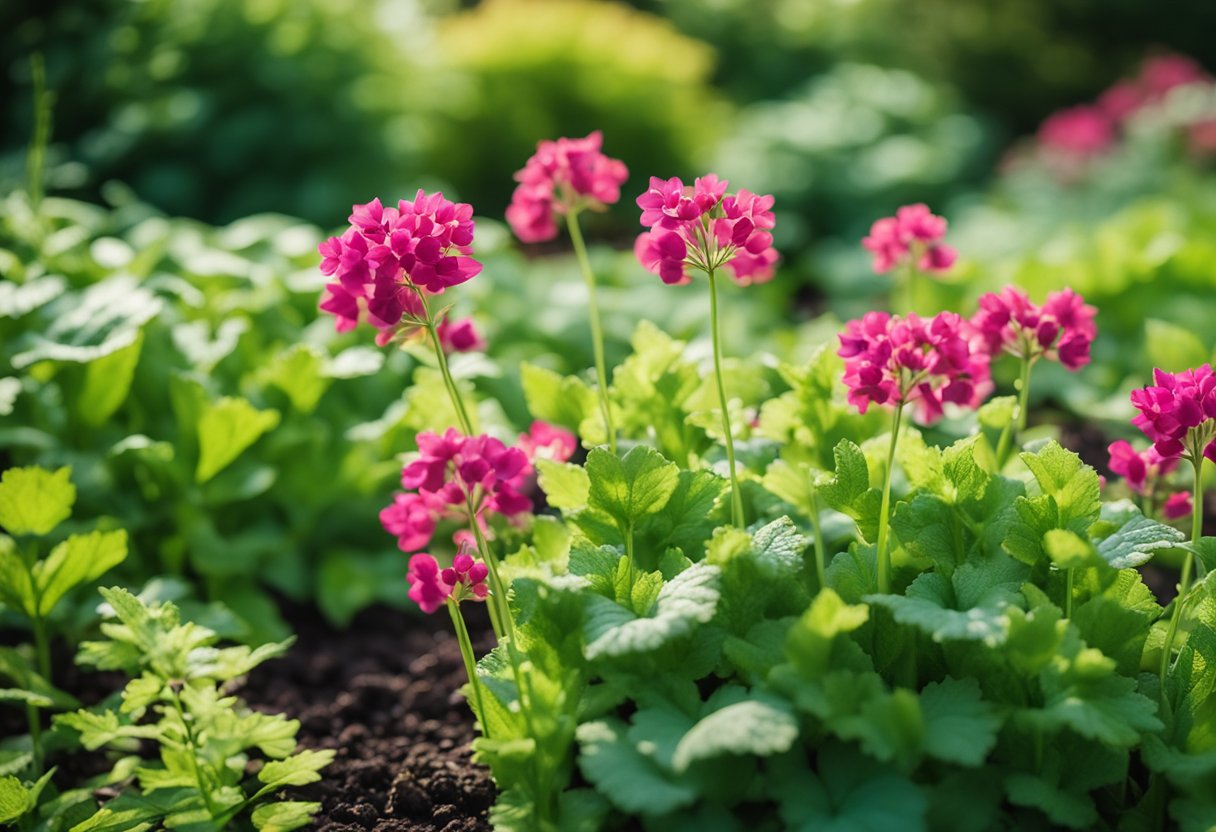
Mulching and Feeding
Mulching is an essential part of taking care of coral bells and their companion plants. Mulch helps to retain moisture, regulate soil temperature, and suppress weed growth. I recommend using organic mulch such as shredded leaves, pine needles, or bark chips. Apply a 2-3 inch layer of mulch around the base of the plants, being careful not to cover the crown of the coral bells.
Feeding your coral bells and companion plants is also crucial for their growth and health. I suggest using a balanced, slow-release fertilizer in the early spring and again in mid-summer. Follow the package instructions for application rates and be sure to water the plants thoroughly after fertilizing.
Pruning and Maintenance
Pruning is an important part of maintaining the health and appearance of coral bells and their companion plants. I recommend removing any dead or damaged leaves and stems as soon as you notice them. This will help prevent the spread of disease and promote new growth.
In the fall, after the first frost, cut back the foliage of the coral bells to about 2 inches above the soil line. This will help protect the plants from winter damage and encourage new growth in the spring.
Regular maintenance tasks for coral bells and their companion plants include watering, weeding, and pest control. Water the plants deeply once a week, or more often during hot, dry weather. Remove any weeds that appear around the base of the plants, being careful not to disturb the roots. Monitor the plants for signs of pests such as aphids or spider mites and treat them promptly with an appropriate insecticide or miticide if necessary.
By following these simple care tips, you can enjoy healthy, vibrant coral bells and their companion plants in your garden for years to come.
Seasonal Considerations
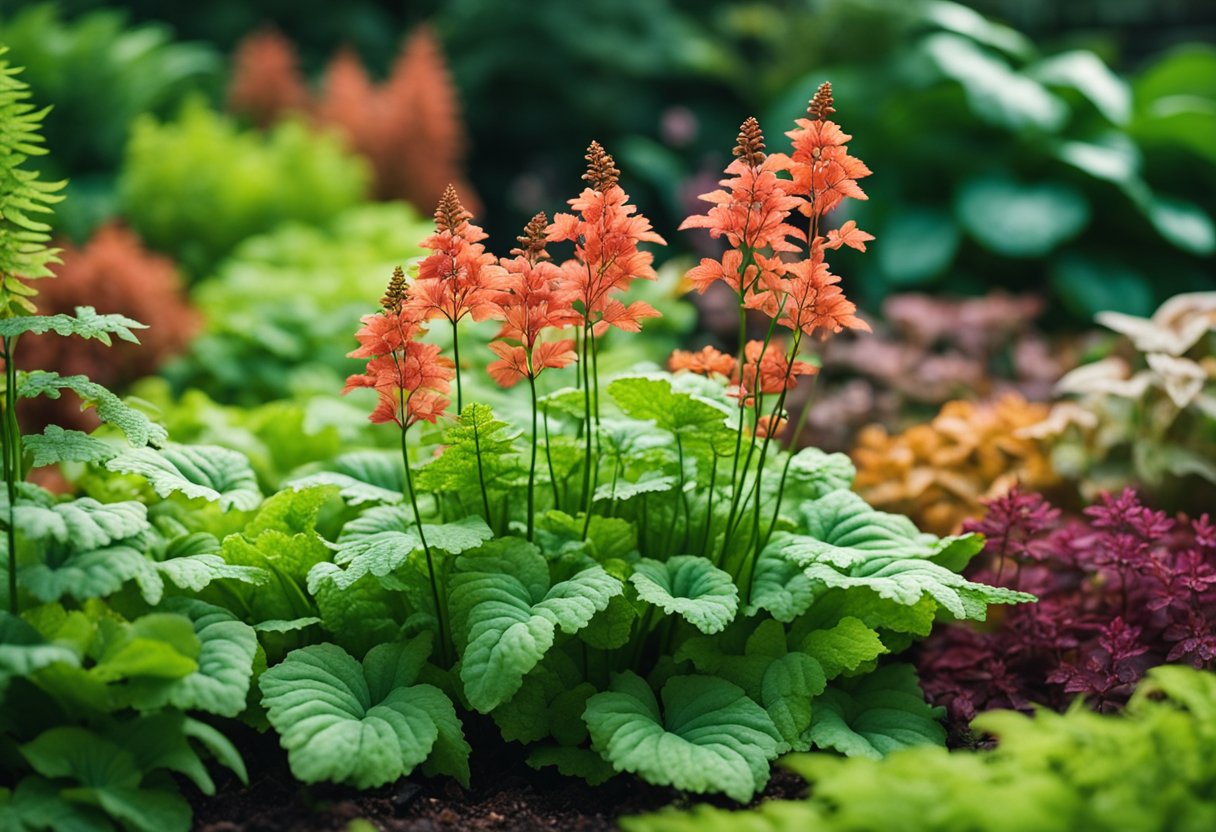
Winter Care
During the winter months, coral bells require some extra attention to ensure they thrive come spring. It is important to keep the soil moist but not waterlogged during this time. Additionally, it is recommended to add a layer of mulch around the plants to help insulate the roots from the cold.
When choosing companion plants for coral bells in the winter, it is important to select those that can withstand the cold temperatures. Some good options include hellebores, which bloom in the winter and early spring, and evergreen ferns, which add texture and interest to the garden even when other plants have died back.
Summer Blooming Companions
Coral bells are known for their stunning foliage, but they also produce delicate, bell-shaped flowers in the summer months. To showcase these blooms, consider pairing coral bells with summer-blooming companions such as astilbe, which produces fluffy plumes of flowers in shades of pink, red, and white, or daylilies, which come in a range of colors and bloom throughout the summer.
Other great options for summer companions include bee balm, which attracts pollinators with its vibrant blooms, and black-eyed Susan, a hardy perennial that produces bright yellow flowers with dark centers. When choosing summer companions for coral bells, be sure to select plants that have similar sun and moisture requirements to ensure they thrive together.
FAQs – Companion Plants for Coral Bells
What plants pair well with coral bells in container gardens?
Coral bells are perfect for container gardens because of their compact size. Some great companion plants to pair with coral bells in container gardens include sweet alyssum, lobelia, and viola. These plants are low-growing and will not compete with the coral bells for space or nutrients.

Which companions are ideal for coral bells during the colder months?
During the colder months, coral bells can be paired with evergreen shrubs like boxwood and holly. These plants will provide a backdrop of greenery for the coral bells’ colorful foliage. Other great companions for coral bells during the colder months include winter pansies, cyclamen, and ornamental kale.
What are the top plants to landscape alongside coral bells for visual appeal?
Coral bells are a great addition to any landscape design because of their vibrant foliage. To enhance their visual appeal, they can be paired with other foliage plants like hostas, ferns, and grasses. Flowers like astilbe, bleeding hearts, and columbine also make great companions for coral bells.
Can astilbe be successfully paired with coral bells, and if so, how?
Astilbe and coral bells make great companions because they both prefer similar growing conditions. Astilbe’s delicate flowers and feathery foliage pair well with the bold leaves of coral bells. When planting these two together, it’s important to make sure they both have enough space to grow and thrive.
What are the preferred growing conditions for coral bells to thrive?
Coral bells prefer well-draining soil that is rich in organic matter. They thrive in partial shade but can tolerate full sun as long as they are kept well-watered. Coral bells should be watered regularly, especially during hot and dry weather. They also benefit from a layer of mulch to help retain moisture and regulate soil temperature.
How quickly do coral bells spread, and what impact does this have on companion planting?
Coral bells are slow-growing and do not spread quickly. This makes them great companions for other plants because they will not take over the garden. When planting coral bells with other plants, it’s important to give them enough space to grow and thrive without crowding each other.